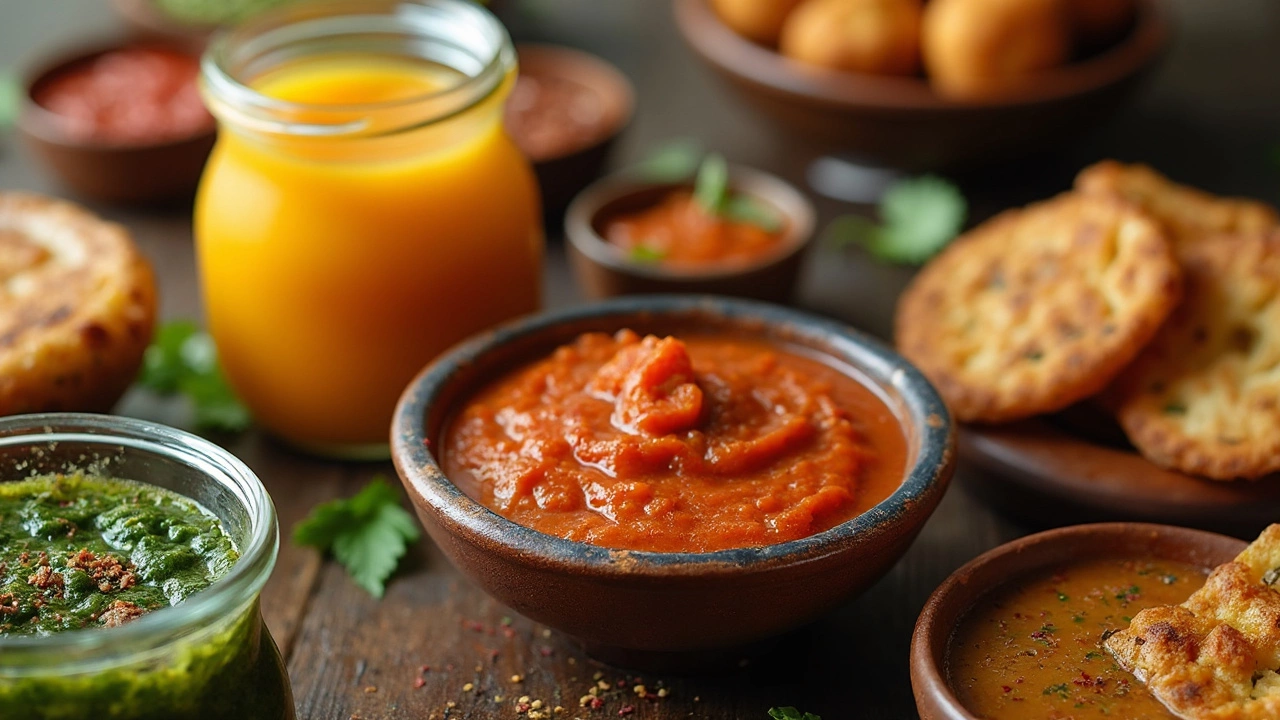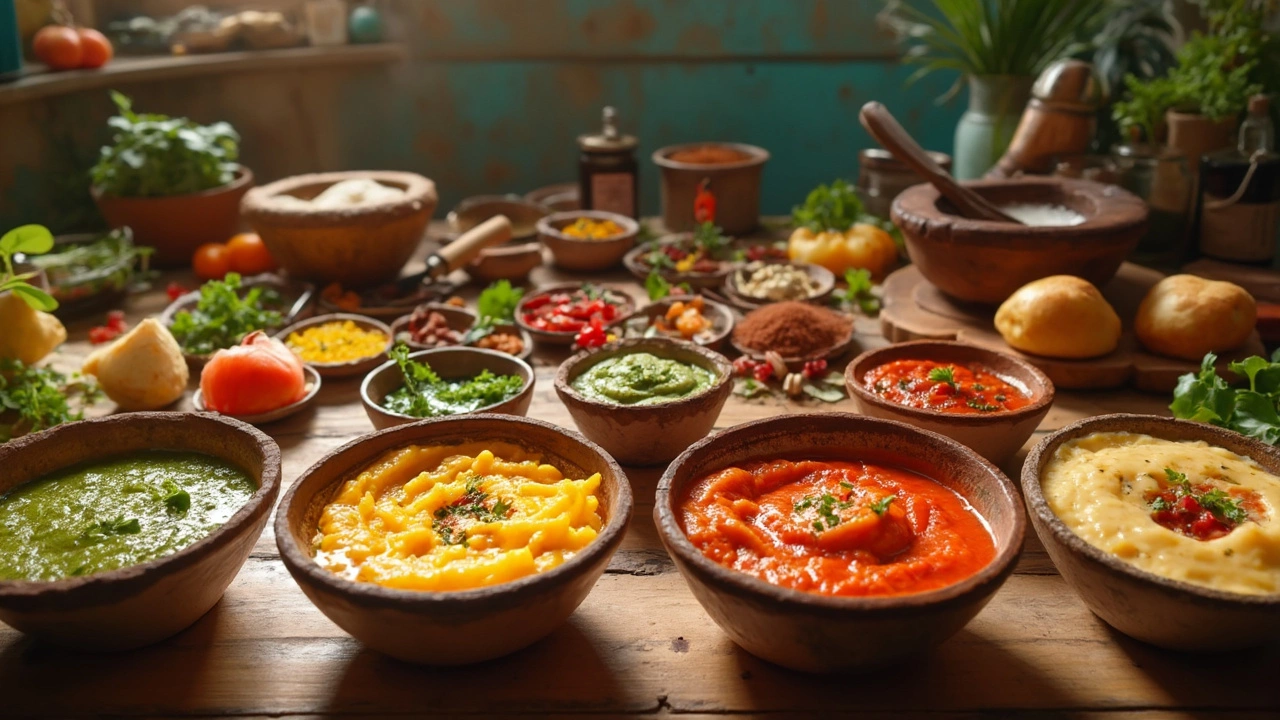Ever stare at a jar of chutney and wonder what you'll get when you crack it open? Chutney isn't just one thing—it can be sweet, sour, spicy, or all of that at once. The magic comes from what goes into it: mango, mint, tomato, tamarind, coconut, or even green chilies. So, every kind hits your taste buds differently.
One spoonful might be bold and tangy, another smooth and mellow. Some chutneys feel like a sharp punch with vinegar or lemon, while others have a mellow sweetness from fruit and sugar. The thing is, they’re always made to wake up your food—think of them as big flavor boosters. Want to know if a chutney might jazz up your next snack? You just need to get familiar with the usual tastes and pairings.
- Chutney Basics: What Is It Anyway?
- The Flavor Spectrum: Sweet, Spicy, Tangy, and More
- Popular Types of Chutney and Their Tastes
- How to Pair Chutney with Food
- Tips for Making and Buying the Best Chutney
Chutney Basics: What Is It Anyway?
So, what’s chutney, really? At its core, chutney is a flavorful condiment that comes from South Asian cooking, mostly India. It typically combines fruits, vegetables, herbs, and spices. You’ll often find vinegar, sugar, or lemon in there too, which gives chutney its signature “zing.” It’s not one-size-fits-all—its texture can be chunky or smooth, thick or pourable.
In India, there are hundreds of types of chutney—some are raw, some are cooked. A few get whipped up fresh with just cilantro, mint, and chili. Others, like mango chutney, are simmered until they’re sticky-sweet and rich. You can find chutney that’s plain green, deep red, or even almost black, depending on the ingredients.
What about outside India? British cooks loved chutney so much during the colonial days that they brought it home, and now you’ll see jars of chutney, like Major Grey’s, in grocery stores worldwide. And it’s not always spicy—some are sweet, tangy, savory, or purely hot.
Here’s a quick peek at what usually goes into a chutney:
- Fruits: mango, tamarind, coconut, pineapple, tomato
- Vegetables: onion, tomato, garlic, coriander
- Spices: cumin, mustard seeds, chili powder, coriander
- Other players: sugar, vinegar, lemon juice, salt
Most people eat chutney as a dip or topping for snacks like samosas or dosas, but it can also jazz up sandwiches, grilled meat, or even cheese. Basically, if your food feels a little boring, spoon on some chutney and watch the flavors pop.
The Flavor Spectrum: Sweet, Spicy, Tangy, and More
When folks talk about chutney taste, they’re really talking about a wild mix of flavors. Chutneys come in an almost endless range, but a few main vibes pop up in every jar: sweet, spicy, tangy, and sometimes even herby or salty.
Let’s break it down:
- Sweet: Mango and apple chutneys are classics in this zone. The sweetness comes from ripe fruit, plus sugar added in the cooking. They’re perfect if you like a little dessert-with-dinner action. These chutneys go well with spicy curries and roasted meats, balancing out heat with a cool, sweet hit.
- Spicy: Love heat? Chutneys with chilies, ginger, or garlic turn things up fast. Even basic mint chutney can deliver a little fire, thanks to added green chilies. This kind wakes up any plain rice or potato dish in a snap.
- Tangy: Tamarind, tomato, or even lemon juice bring a mouth-puckering zing. Tangy chutneys tease your taste buds and make fried snacks or grilled sandwiches way more interesting. If something in your meal feels flat, a tangy chutney usually fixes it.
- Herby/Fresh: Mint, coriander, or coconut chutneys aren’t just about heat. They burst with fresh, green flavors. Mint-coriander chutney is famous at every street food stall, making samosas or kebabs extra lively.
- Salty/Savory: Some chutneys lean into salty goodness, especially ones with peanuts or roasted spices. These are darker, moodier, and make a plate of idli or dosa feel complete.
Most chutneys hit more than one of these notes at once. A mango chutney, for example, often tastes sweet at first, then the ginger sneaks in with spicy warmth, and maybe there’s a tiny sour edge from vinegar or lime.
Here’s a quick look at how some popular chutneys balance these flavors:
| Type | Sweet | Spicy | Tangy | Herby/Fresh |
|---|---|---|---|---|
| Mango | High | Medium | Low | Low |
| Mint-Coriander | Low | Medium | Medium | High |
| Tamarind | Low | Low | High | Low |
| Peanut | Low | Medium | Low | Medium |
| Tomato | Medium | Medium | Medium | Low |
No matter which you try, chutney is about big, bold contrasts. There’s absolutely no one right way to make or eat it, and that’s what makes it so fun to play around with in your kitchen.

Popular Types of Chutney and Their Tastes
There’s no single answer to “what does chutney taste like?” because it totally depends on the type. Different chutneys pack their own punch. The fun part is that these flavor-packed sauces all play a specific role on your plate. Here’s a breakdown of the most well-known chutneys and their main flavor vibes:
- Mango Chutney: Ask someone to name a chutney, and mango probably comes to mind first. Mango chutney mixes sweet, tangy, and spicy in one scoop. Fresh or ripe mango, sugar, vinegar, and spices like ginger and mustard seeds make it sticky, golden, and super bold. It’s the classic partner for curries or even a cheese board.
- Mint Chutney: This one is all about fresh and zesty flavors. With mint, cilantro, green chili, and a squeeze of lemon, it’s sharp, spicy, and cooling at the same time. You’ll find mint chutney at almost every Indian street food stall or next to samosas.
- Tamarind Chutney: Think tangy, sour, and just a hint of sweet. Tamarind chutney gets its bold flavor from tamarind pulp, jaggery (or sugar), and spices like cumin. This deep brown sauce is a go-to dip for pakoras or drizzled over chaat.
- Coconut Chutney: This is a mild, creamy chutney with shredded fresh coconut, green chilies, and sometimes roasted lentils blended together. You’ll see it paired with dosa and idli, giving a nuttiness with just a kick of heat. It’s a breakfast staple in South India.
- Tomato Chutney: Tomato chutney brings a tangy, savory kick with softness from cooked tomato blended with onion, garlic, and chili. Some versions add a touch of sugar for balance. It’s spot-on with rice dishes or on the side of grilled meats and veggies.
Curious about what ingredients go into these chutney recipes? Here’s a quick look at how major types stack up:
| Chutney Type | Main Flavors | Common Ingredients |
|---|---|---|
| Mango | Sweet, tangy, spicy | Mango, sugar, vinegar, ginger, spices |
| Mint | Fresh, spicy, cooling | Mint, cilantro, chili, lemon |
| Tamarind | Tangy, sour, sweet | Tamarind, jaggery/sugar, cumin |
| Coconut | Mild, nutty, creamy | Coconut, chili, lentils |
| Tomato | Tangy, savory, mildly sweet | Tomato, onion, garlic, chili |
No need to stick to these—there are loads of regional twists. But if you’re new to chutney taste, try one of these classics first to get a sense of what you’ll love.
How to Pair Chutney with Food
Pairing chutney with food is actually way easier than it sounds. The main thing to remember: chutney is all about contrast. It brightens up dishes that are flat or mild, but it can just as easily boost bold flavors when you want that extra kick.
If you’ve got a spicy chutney—like a green coriander one or a chili-based variety—try putting it next to something creamy or rich. Classic combos would be samosas dipped in green chutney or using it to jazz up a cheese sandwich. The coolness of the cheese and the punch of the chutney? Perfection.
Sweet chutneys, like mango or apple, work wonders with salty and fried foods. That’s why you’ll see mango chutney next to papadums or fried pakoras in Indian restaurants. The sweetness cuts through the grease and balances flavors out. They’re also a surprise hit with roast meats (turkey, chicken, or even pork), adding a sweet finish that beats boring gravy any day.
Tangy chutneys (think tamarind) are the perfect dip for snacks like bhel puri, chaat, or even potato chips. Their sour notes wake up anything starchy or heavy. If you’re making wraps or sandwiches at home, just spread a bit of chutney inside and you’ll notice the difference straight away.
Pairing ideas to try at home:
- Mango chutney with grilled cheese or ham sandwiches
- Tomato chutney with scrambled eggs or roasted potatoes
- Coriander-mint chutney with samosas, kebabs, or veggie fritters
- Coconut chutney with South Indian dishes like dosa or idli
- Tamarind chutney drizzled over salads, chaat, or tossed roasted chickpeas
Restaurants in India and the UK serve chutneys with street food and curries for a reason: they make everything pop. Even outside Indian cuisine, people use store-bought chutney as a glaze for meats or a side with cheese platters. If you’re hosting, a bowl of chutney with crackers, cheese, and grapes always gets wiped clean.
Here’s a quick cheat sheet to help you decide which chutney goes with what:
| Chutney Type | Best With |
|---|---|
| Mango (sweet) | Grilled meats, cheese platters, rice dishes |
| Coriander/Mint (herby, spicy) | Snacks, sandwiches, barbecued veggies |
| Tamarind (tangy) | Snacks, chats, fried foods |
| Coconut (mild, nutty) | Dosa, idli, rice cakes |
| Tomato (savory, chunky) | Eggs, potatoes, roast veggies |
The point is, there’s no single right way—experiment and see what you like best. Sometimes the best discoveries come from just trying things out in your own kitchen.

Tips for Making and Buying the Best Chutney
If you want your kitchen game to hit next level, knowing how to get the best out of chutney recipes is huge. You’ve got two choices: grab a jar off the shelf or make your own. Here are the tips that actually matter for both.
- Read the label carefully: If you’re buying, check the ingredients first. The shorter the list, the more homemade it tastes. Skip jars loaded with preservatives or weird chemicals if you want that real flavor punch.
- Pay attention to origin and flavors: Different regions make wildly different chutneys. For a true experience, Indian brands almost always win on authentic heat and depth. British chutneys lean sweeter—think mango or plum. Always pick based on what flavors you’re craving.
- Check freshness dates: Chutneys with lots of natural ingredients can spoil faster. Always flip the jar to find the expiry date, especially for fruit or tomato chutney.
- Start simple if you're making it: Try a basic mango or mint chutney first. Both are forgiving and give quick results (in less than half an hour!).
- Mix up your textures: Chunky for sandwiches and cheese, smooth for dipping or mixing in sauces. You control the blender, so try both and see what fits your meals best.
- Salt, sugar, and acid: These three make or break the chutney. Always taste test as you go. A squeeze of lemon or a dash of vinegar can save a bland batch, and a sprinkle of sugar can take the edge off serious heat.
- Don't skip toasting your spices: It might sound like an extra step, but toasting the cumin or mustard seeds before blending unlocks big flavor. It’s a chef’s trick for leveling up homemade chutney flavors.
Looking for numbers? According to a 2023 Indian Food Association survey, roughly 70% of people preferred chutneys where the main ingredients were listed in the top three on the label. When it comes to making it at home, most folks found mango and tomato the easiest to get right on the first try.
| Chutney Ingredient | Best Use | Popularity (2023)* |
|---|---|---|
| Mango | Dipping, sandwiches | 45% |
| Tamarind | Samosas, fried snacks | 20% |
| Mint | Grilled meat, kebabs | 18% |
| Tomato | Spread, cheese | 17% |
*Indian Food Association taste survey, 2023
Whatever you do, always keep it fresh and trust your tongue. You'll find your favorite chutney taste faster than you think.
